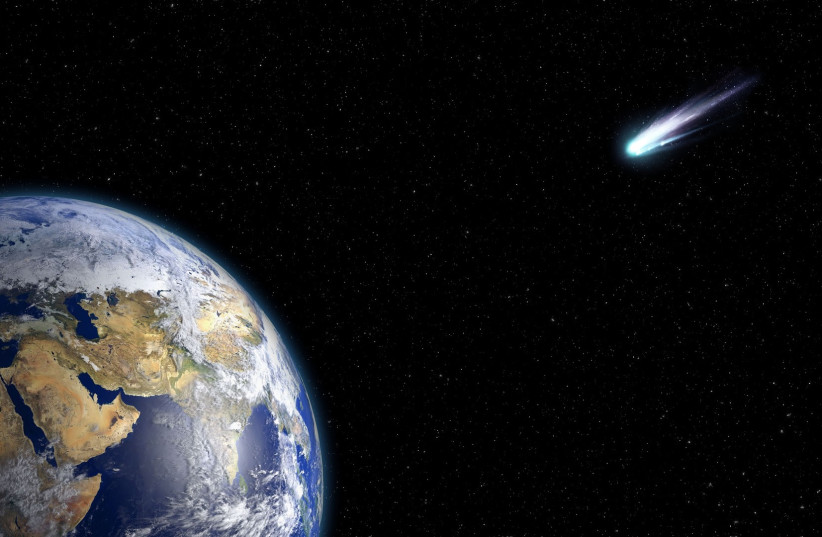 Comet the size of Jerusalem’s Old City flying by Earth – and you can watch
Comet the size of Jerusalem’s Old City flying by Earth – and you can watch
AARON REICH
The comet was designated C/2022E3 (ZTF) and it was discovered in early March 2022 by the Zwicky Transient Facility. It isn’t going to hit us, but it will be visible with the naked eye.

A large newly-discovered comet roughly the size of the Old City of Jerusalem is set to pass by Earth next month, approaching so close that it will be visible to the naked eye.
The comet was designated C/2022E3 (ZTF) and it was discovered in early March 2022 by the Zwicky Transient Facility. However, it isn’t necessarily new, with NASA’s Jet Propulsion Laboratory (JPL) claiming that based on its orbit, the comet may have last passed by Earth around 50,000 years ago, during the end of the last ice age when Neanderthals still walked the Earth and when homo sapiens first started to emerge.
The comet in question is estimated to be around a kilometer in diameter, according to Purnea University in India. This is definitely large, though not as large as the comet NEOWISE that passed Earth in 2020.
Currently, it is already on approach to our direction, hurtling through space, and has been characterized for its very unusual greenish color in the front of the comet, but not in its tail. As for why this color is present, there are possible reasons. Notably, a 2021 study on green comets published in the peer-reviewed academic journal PNAS explained that this is likely due to the presence of C2, which is diatomic carbon, in the head. Solar UV radiation causes it to be broken down by the solar radiation’s photons, a process known as photodissociation. This in turn causes the green glow in the comet’s head, though not in its tail.

What is a comet?
Originally, astronomers thought C/2022 E3 (ZTF) was an asteroid. However, it was later determined to be a comet.
Comets, like asteroids, are one of the most iconic objects found floating around space.
Unlike asteroids, however, which are large rocks, comets are mostly composed of ice and dust, along with some rocky particles. This, in turn, gives them an atmosphere of sorts around the nucleus, though extinct comets lack this and look like small asteroids.
When a comet flies close to the Sun, the heat causes it to warm and release gases. This subsequently forms a large bright trail known as a coma and sometimes even a tail. These can help make the comets much brighter – which, in turn, makes them much easier to spot, even with the naked eye.
Comets, like asteroids, can still theoretically be dangerous, however, should they impact the Earth.
And at a size of around one kilometer, comet C/2022 E3 (ZTF) would certainly be very destructive if it hit the planet.
For context, the Old City of Jerusalem has an area of around one square kilometer, meaning its length and width are each roughly around one kilometer.
But fortunately, NASA has confirmed that comet C/2022 E3 (ZTF) is in no danger of hitting us.
The comet will reach its perihelion, meaning when it is closest to the Sun, on January 12. However, it is on February 1 that it gets its closest to Earth.
This isn’t to say it’s particularly close enough to be dangerous, since it would be around 42 million kilometers away from the planet at its closest. But because comets are so bright, it does mean that it will be visible at night with the naked eye, assuming you have a dark enough sky.
And of course, having the right equipment on you will make your viewing experience even better. Otherwise, while the comet will be visible, it will be faint.
But you don’t need to wait until then to try and see it. If you have a powerful enough telescope, stargazers can already start trying to spot this large comet in the night sky.
And if you still can’t wait, don’t worry. The Virtual Telescope Project is going to set up a livestream starting January 12 for you to watch the comet as it shoots through Earth’s night sky.
When will comet C/2022 E3 (ZTF) come back toward Earth?
Here’s the bad news.
While many comets do have orbits that see them return to Earth every now and then, that doesn’t mean this comet will be one of them.
As noted by Paris Observatory astrophysicist Nicolas Biver, the comet may just be headed on a course to exit our solar system entirely, being flung on an intergalactic journey throughout the reaches of the Milky Way Galaxy, AFP reported.
So come watch comet C/2022 E3 (ZTF) and get ready to say goodbye. The last time it was here was 50,000 years ago, and this may be its final journey past our humble planet before it shoots off into the greater cosmos.
Zawartość publikowanych artykułów i materiałów nie reprezentuje poglądów ani opinii Reunion’68,
ani też webmastera Blogu Reunion’68, chyba ze jest to wyraźnie zaznaczone.
Twoje uwagi, linki, własne artykuły lub wiadomości prześlij na adres:
webmaster@reunion68.com
